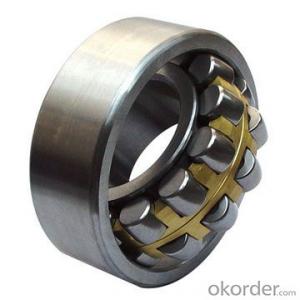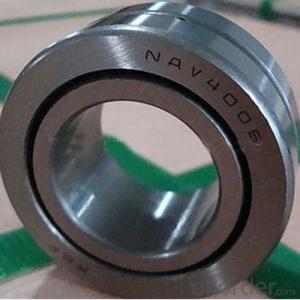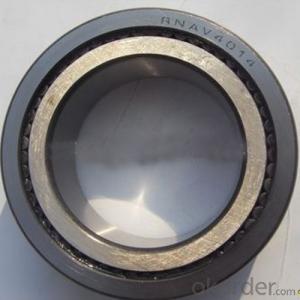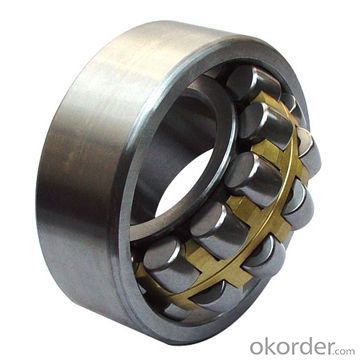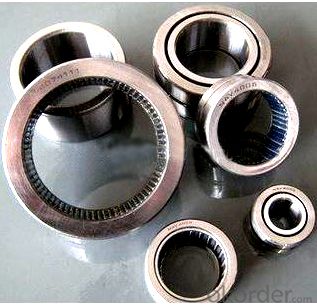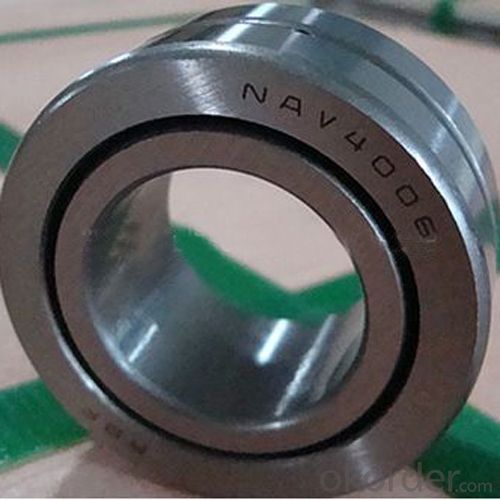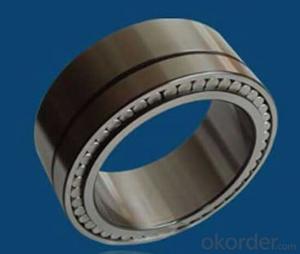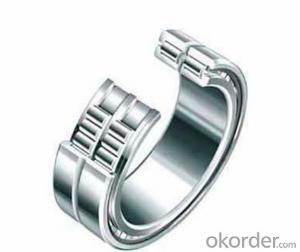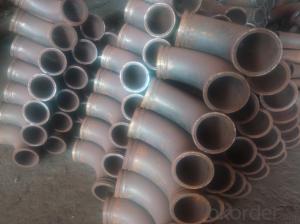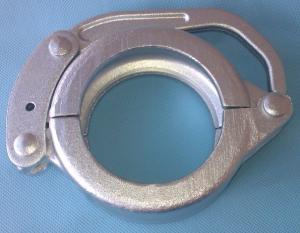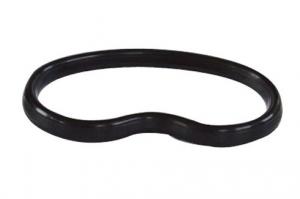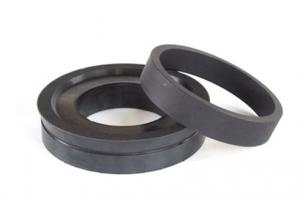Full Complement Needle Roller Bearing HRC60
- Loading Port:
- Shanghai
- Payment Terms:
- TT OR LC
- Min Order Qty:
- 1 pc
- Supply Capability:
- 1000 pc/month
OKorder Service Pledge
OKorder Financial Service
You Might Also Like
Product information:
As for the full complement needle roller bearing with inner ring,the outer ring has the oil hole.The lubricating oil can be fed in from the oil hole. The outer ring has the double shoulders. As for the full complement needle roller bearing without inner ring,since the inner ring has no shoulder and cage,the inner ring,outer ring,complete set of needles can be mounted respectively.It is s suitable for parts of which the radial size is limited.The surface of shaft journal fitted with it is acted directly as rolling surface.
Size:
NAV4914
NAV4014
NAV4015
NAV4916
NAV4016
NAV4017
NAV4918
NAV4919
NAV4920
NAV4832
Salient features:
It is requested that the surface hardness be no less than HRC60,surface roughness,no more than 0.63μm. This kind of full complement bearing, with inner ring or without inner ring,does not limit the axial shift of shaft and housing.
Since this kind of bearing has no cage,the needles rotate without correct guiding,they rub heavily against each other and the bearing has the low limiting rotational speed.
Advantages of our products:
Premium quality
· Prompt delivery & seaworthy packing (5-10 days)
Reliable performance
Easy to weld
High safety.
· Professional Service
· Competitive pricing
Measuring of wall thickness from the outside
Low purchase cost
FAQ:
Q1: How long about delivery time?
A1: Normally we keep the raw materials for old customers and sometime we also keep stock products to make sure delivery time in any emergency cases.
Q2: How do we guarantee the quality of our pipes?
A2: We have established an advanced quality management system which conducts strict quality tests at every step, from raw materials to the final product. At the same time, we provide extensive follow-up service assurances as required.
Q3: How soon can we receive the product after purchase?
A3: Within three days of placing an order, we will book the vessel for goods. The specific shipping date is dependent upon international and government factors, but is typically 7 to 30 workdays.
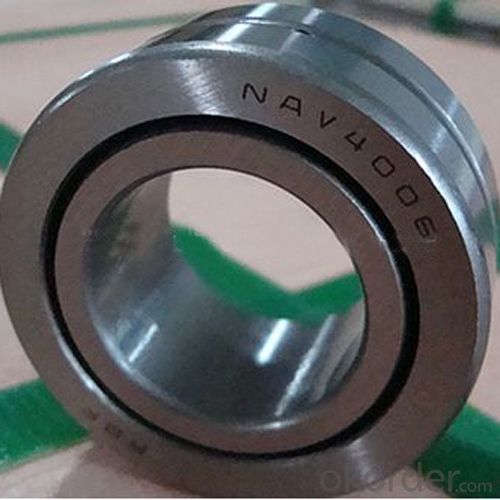
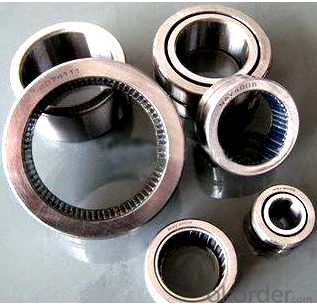
- Q: How long do concrete pump pipes typically last?
- Concrete pump pipes typically last between 25,000 to 40,000 cubic meters of concrete pumped. However, the lifespan of these pipes can vary based on several factors such as the quality of the pipes, the type of concrete being pumped, the pumping pressure, and the maintenance practices followed. Regular inspections, cleaning, and proper storage can help extend the lifespan of concrete pump pipes. Ultimately, it is essential to monitor the wear and tear of the pipes and replace them when necessary to ensure efficient and safe concrete pumping operations.
- Q: How is a concrete pump pipe different from a regular pipe?
- A concrete pump pipe is specifically designed to be used in concrete pumping applications, whereas a regular pipe is more commonly used for general plumbing purposes. Concrete pump pipes are typically made of high-quality and durable materials to withstand the high pressure and abrasive nature of pumped concrete. They also have specialized ends, such as flanges or couplings, to provide a secure connection between the pump and the delivery system. In contrast, regular pipes may come in various materials and sizes, depending on their intended use in plumbing systems.
- Q: What do these types of concrete pumps mean?
- 160 is the engine (or motor) rated power 160KW, and should also have 1-3 letters, RSU, said the diesel engine, S pipe ground pump, no R that is the motor pump, and some is only Z, that is the gate pump.
- Q: Which height of concrete pump is the most practical?
- The clay pump truck is modified on a truck chassis. It is mounted on the chassis with a power and motion device, a pump and a mixing device, a cloth arrangement, and other auxiliary devices
- Q: Are there any specific troubleshooting steps for identifying issues with concrete pump spare parts?
- Yes, there are specific troubleshooting steps for identifying issues with concrete pump spare parts. These steps typically involve inspecting and testing the spare parts for any visible damage, checking the compatibility of the parts with the concrete pump system, ensuring proper installation and alignment, and testing the functionality of the parts under normal operating conditions. Additionally, consulting the manufacturer's guidelines and seeking professional assistance can also help in identifying any issues with concrete pump spare parts.
- Q: How can a faulty electric motor affect the pump's performance?
- A faulty electric motor can have a significant impact on the pump's performance. Firstly, the motor is responsible for providing the necessary power to drive the pump. If the motor is faulty, it may not be able to generate the required amount of power, leading to a decrease in the pump's performance and overall efficiency. This can result in reduced flow rates and lower pressure output, leading to inadequate functioning of the pump. Moreover, a faulty motor can also lead to issues such as increased energy consumption and overheating. If the motor is not functioning properly, it may draw excessive electrical current, causing higher energy usage and increased operational costs. Additionally, an overheating motor can result in damage to the pump and other related components, further impacting performance and potentially leading to costly repairs or replacements. Furthermore, a faulty motor can also impact the reliability and longevity of the pump. Continuous operation with a faulty motor can put excessive strain on the pump, leading to premature wear and tear, increased maintenance requirements, and a shorter lifespan. This can result in frequent breakdowns, downtime, and a decrease in overall productivity. Overall, a faulty electric motor can have various negative effects on the pump's performance, including lower flow rates, reduced pressure output, increased energy consumption, overheating, and decreased reliability. It is crucial to regularly inspect and maintain motors to ensure their optimal functioning and avoid any detrimental impacts on the pump's performance.
- Q: What are the different types of concrete pump hoses?
- There are generally two types of concrete pump hoses: steel-reinforced hoses and fabric-reinforced hoses. Steel-reinforced hoses are stronger and more durable, suitable for high-pressure applications and long-distance pumping. Fabric-reinforced hoses are lightweight and flexible, ideal for smaller projects and shorter pumping distances.
- Q: What is the function of a concrete pump water pump?
- The function of a concrete pump water pump is to supply water to the concrete pump system, aiding in the smooth and efficient operation of the equipment.
- Q: What are the different types of concrete pump rubber pistons?
- There are several different types of concrete pump rubber pistons available in the market, each designed for specific applications and requirements. Some of the commonly used types include: 1. Single-Action Piston: This type of piston is designed to push the concrete forward during the pumping process. It moves in a single direction, providing a consistent and efficient flow of concrete. 2. Double-Action Piston: Unlike the single-action piston, the double-action piston can move in both directions. This allows for a more versatile pumping process and can be useful in situations where there are obstacles or restrictions in the pump line. 3. Steel Reinforced Piston: These pistons are reinforced with steel to provide additional strength and durability. They are commonly used in high-pressure pumping applications or when pumping abrasive materials. 4. Polyurethane Piston: Polyurethane pistons are known for their excellent wear resistance and longevity. They are often used in demanding pumping conditions where durability is crucial. 5. Rubber Sponge Piston: Rubber sponge pistons are designed to have a soft and flexible surface, allowing them to conform to irregularities in the pump line. They are particularly useful in situations where there may be bends or corners in the line. 6. Bonded Piston: Bonded pistons are made by bonding a rubber or polyurethane material to a metal core. This combination provides both the flexibility of rubber and the strength of metal, making them suitable for various pumping applications. It is important to choose the right type of concrete pump rubber piston based on the specific requirements of the project. Factors such as pumping pressure, material being pumped, and environmental conditions should be considered to ensure optimal performance and longevity of the piston.
- Q: How can one determine the correct hardness and durometer rating for rubber components in concrete pump spare parts?
- Several factors must be taken into consideration when determining the appropriate hardness and durometer rating for rubber components in concrete pump spare parts. To begin with, it is crucial to have a thorough understanding of the specific application requirements of the rubber components. This entails considering factors such as pressure, temperature, and frequency of use. Additionally, it is important to assess the compatibility of the rubber material with concrete and any other chemicals that may come into contact with the components. Ensuring chemical resistance is vital for guaranteeing the longevity and durability of the rubber parts. Furthermore, the anticipated load and stress on the rubber components must be carefully analyzed. This includes evaluating the weight of the concrete, the force exerted during pumping, and the potential for impact or abrasion. Moreover, environmental conditions should not be overlooked. Exposure to sunlight, extreme temperatures, or harsh weather conditions can significantly impact the performance and lifespan of rubber components. It is also essential to consider the specific type of rubber material being used. Different rubber compounds possess varying hardness and durometer ratings. Seeking guidance from rubber manufacturers or suppliers who specialize in concrete pump spare parts can provide valuable insights and recommendations based on their expertise and experience. Ultimately, determining the correct hardness and durometer rating for rubber components in concrete pump spare parts necessitates a meticulous evaluation of application requirements, compatibility, load and stress factors, environmental conditions, and expert advice.
Send your message to us
Full Complement Needle Roller Bearing HRC60
- Loading Port:
- Shanghai
- Payment Terms:
- TT OR LC
- Min Order Qty:
- 1 pc
- Supply Capability:
- 1000 pc/month
OKorder Service Pledge
OKorder Financial Service
Similar products
Hot products
Hot Searches
Related keywords
